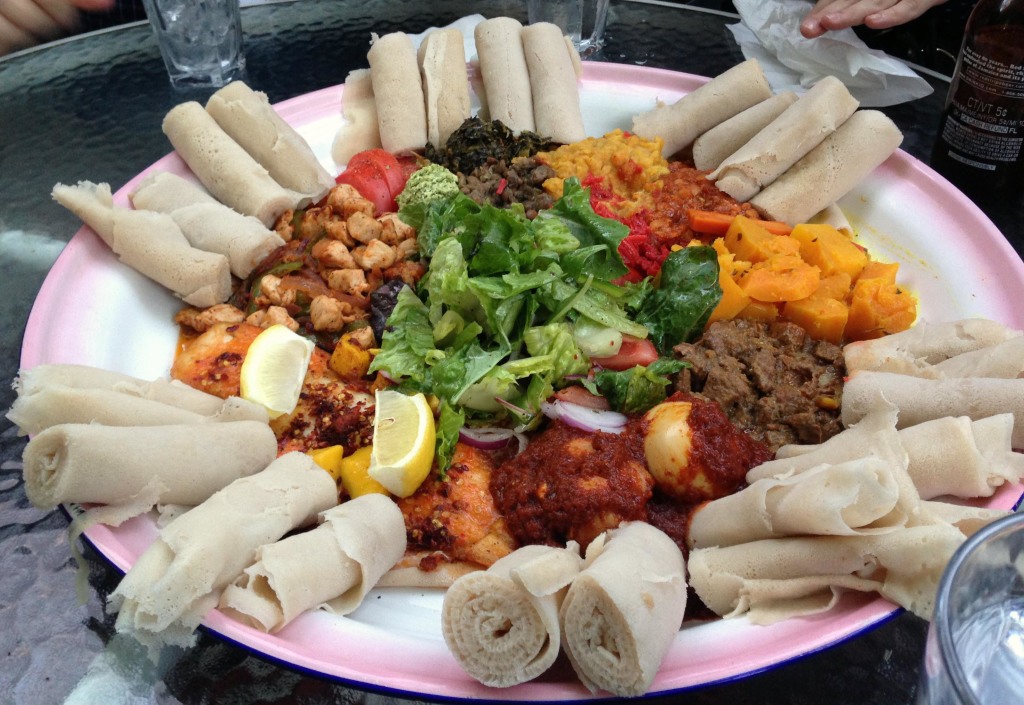
Gursha
by Marissa Landrigan
On one of the first nights I lived in Washington, D.C., my new roommate sat me down with a map of the city. She took out a red sharpie and began circling neighborhoods to avoid. Meridian Hill Park, just blocks from our apartment, was fine and beautiful during the day, but there had been a recent string of sexual assaults there after dark. Columbia Heights, the next neighborhood to the West, was a known drug hub. Needles in the street. Red x’s on streets where a young woman shouldn’t walk alone.
This was my introduction to the city – a complex maze to navigate, with much to fear.
In late August, a friend from college called to say she would be in town to interview for her own future internship, and to ask if I wanted to grab dinner and catch up. When Kate arrived at my apartment, she was so excited to have passed Meskerem on her way up the block, saying she’d always wanted to try Ethiopian food. The dutiful hostess, I agreed. In sandals and shorts, we perched on leather stools around a small, red table and let the waiter order for us, the sting of red pepper in my nostrils.
I had no reason to believe I would like Ethiopian food. Just sitting in the building, I felt like a trespasser, certain I would embarrass myself by clattering with strange utensils, gagging, sweating with the heat of the food. My fear intensified as the waiters in loose white shirts and maroon slacks brought our dinner on large metal platters and stayed to explain the dishes: Gommon watt, a steaming wilted collard greens stewed in berbere, a spicy red pepper. Kik Alitcha, a soupy yellow substance, split peas simmered in an onion sauce. Misir Azifa, finely chopped onion, green chile, pureed lentils. Unfamiliar ingredients and heavy spice. My stomach turned nervously. But I couldn’t admit this fear, couldn’t acknowledge that I was still just the white suburban girl, afraid to try new things.
For many of my childhood friends, leaving New Hampshire and going out into the wide world was their first opportunity for exposure, the first chance they had to meet people from other regions and try other foods. A city friend takes you out for sushi. A Texan friend cooks black-eyed peas, tamales. An Iranian roommate brings home a pomegranate. Somehow, they were born with a willingness to the world, the ability to open themselves to new ideas and experiences. They were unafraid, unabashed, welcoming, experimental. They did not hide their newness. They celebrated.
My mother gave me these opportunities, exotic, cultural, international. I knew what Chicken Tikka Masala was before I was twelve. She made summer tabouleh in pita, homemade sesame tahini sauce. But before I ever left my parents’ house, my walls were up. Where my friends saw possibility, an abundance of ingredients, a source of experimentation and growth, I shrank in fear, my taste buds too sensitive, too stubborn. I wasn’t interested in trying new things if they would just make me gag. New cities, new languages, new foods, didn’t excite me—they made me nervous. I never allowed myself to imagine I could belong.
But as the waiters began to lead us in a demonstration of Ethiopian eating technique, the anthropologist in me turned on, leaned in slightly to get a better look, curious of cultural phenomenon. They broke off pieces of the injera, a floppy, spongy flatbread, and used it as a finger-held utensil to scoop up bites of each dish straight into their mouths. No silverware. Lots of sharing. Concern over the alien foods gave way to an eager desire: the novelty of eating sloppily and loudly, with my hands, in public. We followed the waiters’ demonstrations, giggling awkwardly, turning to our neighboring tables to laugh together. The waiters encouraged us to interact with other customers, explaining that cross-table sharing was common, extending the notion of family-style entrées. Later, when business slowed, they returned to our table, laughing at our messiness, wrapping their hands around ours, helping to guide the spicy foods into our inexperienced mouths.
D.C. has the highest concentration of Ethiopians anywhere in the United States—more than 150,000 migrants in a ten-square-mile city. In fact, the city boasts the largest Ethiopian population anywhere in the world outside of Ethiopia itself. That night at Meskerem, I sensed this abundance, felt it wrap around me, the ease with which an uncomfortable outsider was welcomed in.
The menu at Meskerem explains sharing injera as more than just an eating technique. Eating from the same plate, or breaking injera together, symbolizes the bonds of loyalty and friendship. When two people share a plate, they demonstrate their respect for one another, through the connection inherent from trusting each other with food. The act connects person to person, but also person to food, removing the sterile boundary of the fork. The height of this connection is gursha—the act of placing food from one’s own hand into another’s mouth.
I understood in my Italian bloodlines the tenderness of feeding the ones you love. My great-grandmother’s hands sank deep into the food that went straight into our mouths. No sterility. No gloves while rolling meatballs, while carrying spaghetti. Her food was a consecration, a gift for someone else. When I watched other people in the restaurant that night, I understood the ritual of giving food to another person as an offering. What fascinated me, instead, was the opening of the self. The trust of welcoming another’s hand into your mouth. The willingness to come into contact with the whole world, safe or not.

Marissa Landrigan’s work has appeared in The Atlantic, Creative Nonfiction, Guernica, Orion, The Rumpus, and elsewhere. She received her MFA in Creative Writing and Environment from Iowa State University, where she completed a food memoir titled The Vegetarian’s Guide to Eating Meat, from which this piece is excerpted. She currently teaches writing at the University of Pittsburgh – Johnstown.

Comments are closed.